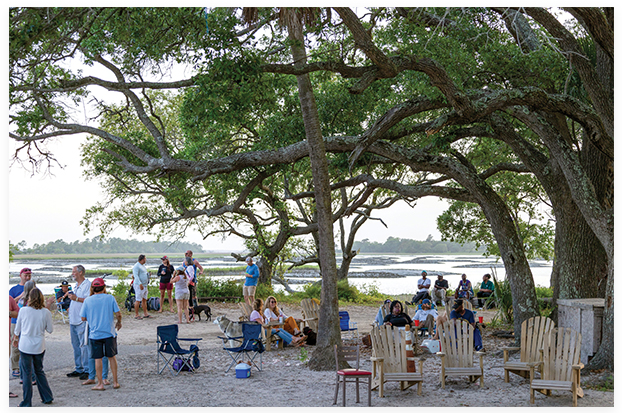The Gullah CVB hosts Sunset Jamz at the historic beach on Tuesdays

Lives: John’s Island
Education: Studio art degree from the College of Charleston
Family: Daughter, Talulah Adele Tant
Organizations she’s cofounded: Growing Spirit nature programs; the Gullah Convention & Visitors Bureau; Local Pulse (the digital presence of the Gullah CVB)
The sky turns orange, then purple, while saxophonist Bill Wilson gently sets the serene mood. These Sunset Jamz are held on Tuesday evenings at Mosquito Beach, a sandy area along the marsh off of Sol Legare Road, where Black people often gathered during Jim Crow segregation. Today, it’s a historic district, placed on the National Register of Historic Places in 2019 and enjoying a multicultural resurgence, thanks, in part, to the efforts of the Gullah Convention & Visitors Bureau (CVB). Willis “Quaponda” Tant and a group with generational roots on Sol Legare known as the Quaponda tribe launched the Gullah CVB in 2022 to help promote the culture and small businesses of people with Gullah heritage.
Activism and community building are in Tant’s nature. She’s also the founder of Growing Spirit, a camp and homeschool-oriented nature curriculum on John’s Island. After returning from a season supporting the Standing Rock Sioux Tribe in their fight against the Dakota Access Pipeline, she met her partner in founding the Gullah CVB, chief Halo Quaponda. Here, Tant shares their vision for the Gullah CVB.
CM: What sparked your passion for supporting indigenous and minority communities?
WQT: I grew up near Nashville. I had a mother who was very diseased with alcoholism, so because of that, I listened to Mother Earth, which led me to indigenous ways. When I was 16, I started driving to Cherokee, North Carolina. I’d camp with my dog and meet the artists in the shops there, and sometimes, they’d invite me back to their home to show me more of their work. I was thirsty for that kind of listening, because it’s timeless and connected to our source of life.
CM: What brought you to Charleston?
WQT: I graduated high school in 1996, and I’d never seen the ocean. My best friend and I drove down, and I saw dolphins for the first time. I saw the “Jesus Man” mural at Septima P. Clark Parkway and President Street, and I felt hooked on the vibe. I enrolled at College of Charleston and rode a rickshaw for work.

CM: What’s the story behind the Growing Spirit nature programs for children you host on John’s Island?
WQT: We teach archery and build forts and have a zipline and kayaks. It’s got the right balance of structure and freedom with activities that keep them in tune with their bodies and nature. Most of the counselors today are kids that grew up out here. We’ve developed a curriculum to emphasize honoring the indigenous in a way that’s tangible, honest, and open.
CM: What’s the primary goal of forming the Gullah CVB?
WQT: Forming a CVB makes us eligible for accommodations tax dollars we can use to encourage tourism that actively honors Gullah culture and community. Tourism can enhance local life, not just gentrify and subtract from it.
CM: How do the Sunset Jamz on Sol Legare fit into that picture?
WQT: People come out to experience a living community in a historic location. They come for the beautiful scenery, the music, and delicious food, but they also get a taste of culture. If someone is willing to talk to people and listen, they can really deepen their understanding of their community in Charleston and what Gullah culture is all about.
CM: What other projects do you have in the works?
WQT: We’re working on launching Gullah Living Arts & Tours, beginning with a farmers market every Saturday afternoon. Our respect for our environment will continue to connect everything we do. Nature inspired and taught me how to talk to kids. Now, I’m leaning on history to teach me how to change the future.